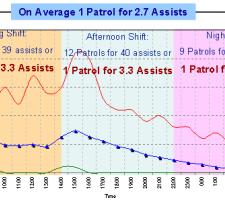
Jean Harito, Attica Tollway Operations Authority and Steve Morello, Egis Projects describe how looking to exceed contractual obligations makes good operational and business sense
The Attica Tollway is a modern, 65km, access-controlled urban motorway with three lanes in each direction. It constitutes the ring road around the extensive metropolitan area of the Greek capital, Athens, and forms the backbone of the entire road network in the Attica region. By ensuring freeflow operating conditions, the Attica Tollway facilitates speedy connections between 30 municipalities in Greater Athens.Constructed on a concession basis, it constitutes the largest co-financed road project in Greece and one of the largest in Europe.
The project was launched by the Greek state in the early 1990s and following a competitive tender the concession was awarded in 1996 to the Attiki Odos consortium. Since at the time there was no general legal framework for dealing with concession projects, the contract had to be ratified by the
The Attica Tollway project was a classic BOT project, with the Greek Ministry of the Environment, Physical Planning and Public Works as project owner, Attiki Odos SA as the concession, Attiki Odos JV as the construction joint venture, and
The Average Annual Daily Traffic (AADT) rose from 231,000 entries
onto the motorway in 2004 to a peak of 307,000 in 2009 prior to onset of the financial crisis in Greece. In 2010, traffic levels tapered off to 281,000 AADT. These figures correspond to 6-10 per cent of the total traffic in the Athens metropolitan area.
Imperatives and differentiators
The traffic management contractual obligations require smooth, uninterrupted traffic flow throughout the Attica Tollway. This includes management of detected incidents within 10 minutes, plus 10 minutes maximum response time. Another performance requirement concerns light vehicles immobilised on the motorway due to breakdowns or other incidents, which must be recovered and evacuated. The main incident management parameters include: free-of-charge intervention and towing services; standby assistance units; an emergency hotline service; and cooperation with the emergency services.One of the highest priorities for the Attica Tollway Operations Authority was implementation of high-quality services for road users and Electronic Toll Collection (ETC) subscribers above and beyond the contractual requirements. Taking as a baseline reference the operation and maintenance practices of the French motorways, the Attica Tollway Operations Authority developed a high level of service for the benefit of users and ETC subscribers. After the initial opening in 2001, Attica Tollway embarked on an ambitious programme to increase ETC take-up based on this service offering.
The toll system is open and flat (the toll is due at entry to the motorway whatever the distance travelled). Two methods of payment are accepted in lanes: cash and e-Pass (ETC tags). Users with valid tags can drive through the lanes without stopping. ETC tags are accepted in all lanes while dedicated ETC lanes are also provided. Account opening and top-up can be via phone, a website or the Customer Service Centre located at the main toll plaza. A huge amount of training is directed at those public-facing staff and team dedicated to responding to phone calls or written complaints has been built up to reinforce the aggressive commercial policy developed to promote ETC. By the end of 2004, e-Pass collection represented 30 per cent of collected tolls and the number of tags in circulation has constantly increased since introduction in June 2002.
Traffic management
The main goal of Attica Tollway's approach to traffic management was to improve safety by reducing incidents and accidents, and to maximise the capacity of the motorway by managing congestion. In 2001, this was an important improvement brought to Greece concerning traffic management of tollways and since then the level of service provided by Attica Tollway has become the reference for all new motorway concessions in Greece. The fatality rate, which at the national level in Greece was one of the worst in Europe, has been dramatically decreased on the Attica Tollway, achieving levels very similar to those observed in France and Germany.The heart of the traffic management system is the Traffic Management Centre (TMC) located on the motorway and operating on a 24/7/365 basis. TMC operators continuously monitor the motorway's traffic and road conditions and take advantage of advanced ITS applications and systems to interact with competent emergency service authorities whenever an incident occurs. Patrol units, dispatched 24/7/365 along the entire length of the tollway, assist the TMC in detecting incidents and provide assistance free of charge to road users. There are emergency roadside telephones located every 50m inside tunnels and every 2km along the motorway and the company provides a four-digit (1866) emergency telephone number which users may dial from their mobile telephones.
Incident detection and actions
The incident detection and response time obligation of the concession contract was the key driver of development of a comprehensive network of patrol units to detect anything unusual within 10 minutes and/or to respond within the same timeframe. This solution was preferred at the outset to an Automatic Incident Detection (AID) system due to the fact that, even if the incident is automatically detected, there is a service level requirement of action and response from a patrol unit or an intervention team. According to the time of day, up to 12 patrols units are simultaneously monitoring the tollway for incidents, and around 100 incidents per day are recorded by the traffic management system. In fact, more than 50 per cent of recorded incidents are detected by the patrols which immediately take the necessary remedial actions. Figure 1 provides an overview of patrol service configuration.The response time after detection of an incident averages five to six minutes, which is considerably better than the concession requirement. Figure 2 provides an overview of the response times for the various stakeholders involved in traffic management.
In 2007, a series of tests with various AID vendors was carried out as part of a potential plan to upgrade the TMC, provide control room operators with additional means of detecting and responding to incidents, and reduce the number of patrol units circulating at any given time. In-tunnel results were very positive. However, local light and weather conditions led to numerous false alarms along open sections of the motorway. Given the requirement for almost immediate roadside support in the event of an incident, the planned upgrade of roadside equipment is still being reviewed.
Measuring performance
To determine the consequences of incidents, and particularly their effects on congestion, in July 2005 the Attica Tollway implemented the PeMS freeway performance measurement system. Originally developed for theThe PeMS system deployed for the Attica Tollway includes freeway detector data for every 20 seconds of volume, speed and occupancy from over 1,000 loops, incident data and toll data. PeMS checks the data for accuracy and processes this data every day to compute performance measures. The results are viewed via an extensive set of web pages. Examples include plots of flow and speed over time of day/day of week to see temporal trends. Contour plots of speed or occupancy provide directly the spatial and temporal extent of congestion and assist in determining bottleneck locations. PeMS uses the flow and speed data to compute performance measures that can be easily understood by the system manager (vehicle miles or, vehicle hours travelled), and the system user (delay and travel time). Delay is computed as the additional vehicle hours travelled driving at below freeflow speed (taken to be 100kph/60mph). PeMS is continually enhanced with features to meet the special needs of the Attica Tollway operations. Recent enhancements include: incident data visualisation and statistical analysis; origin-destination matrix estimation; automated flow balancing from loop detector and toll data; and route performance through dashboards and other visualisations.
Conclusions
In most countries around the world, the general public objects to paying tolls. This can have several negative effects: public opposition to the implementation of a toll regime is a major risk for all toll road projects (and in the case of DBFO projects may significantly affect project revenues); financing becomes very difficult (if not impossible); and negative results are created for project sponsors.Since the opening of the Attica Tollway in 2001, Attica Tollway Operations Authority has worked hard to improve the level of service in terms of safety for users, incident management, maintenance, ETC performance and overall customer satisfaction. This goal has been achieved thanks to a strategy of excellence based on Key Performance Indicators (KPIs) which serve as a mechanism to monitor value and maintain an excellent level of service: 35 KPIs are evaluated on a monthly basis covering the entire spectrum of operations, 11 of which relate to incident management; and two KPIs are related to contractual requirements.
The main achievements of Attica Tollway concerning guaranteed travel times and smooth traffic flow conditions are important results in the development of toll roads in Greece because the project has changed public attitudes towards paying tolls, created the perception that PPPs are a good thing and confirmed that the user pays principle is socially fair. Finally, Attica Tollway has demonstrated that it pays to implement practices extending above and beyond contractual obligations.














